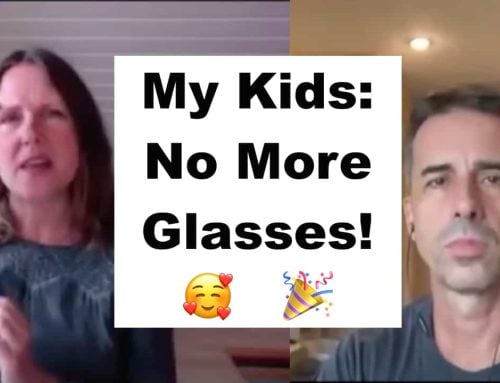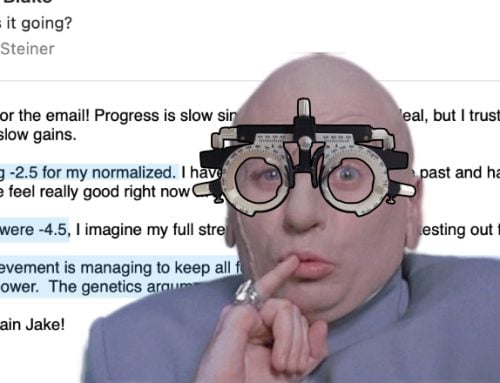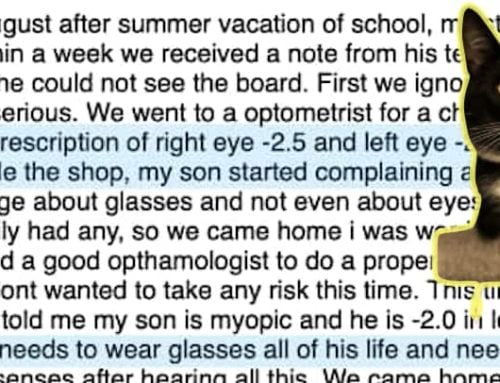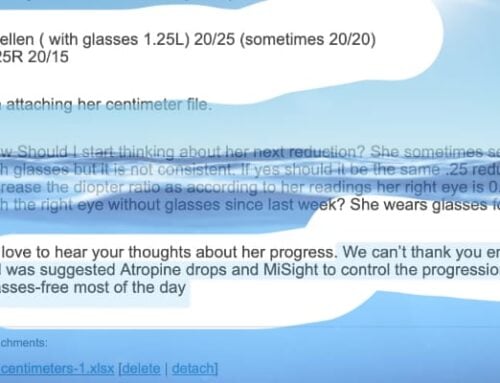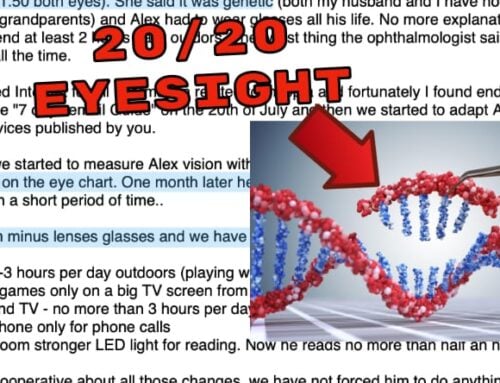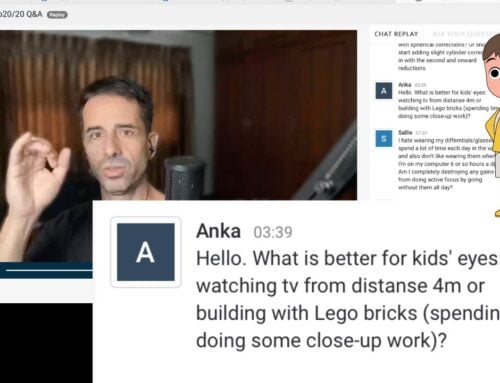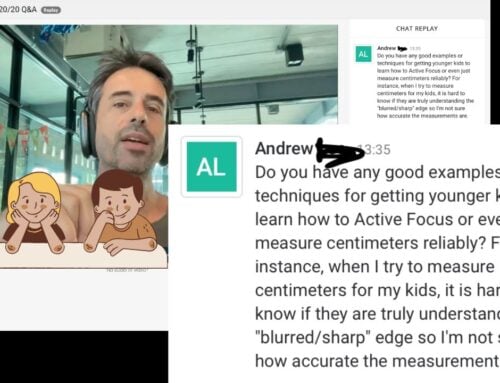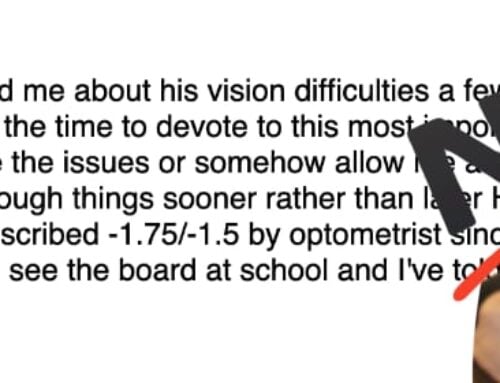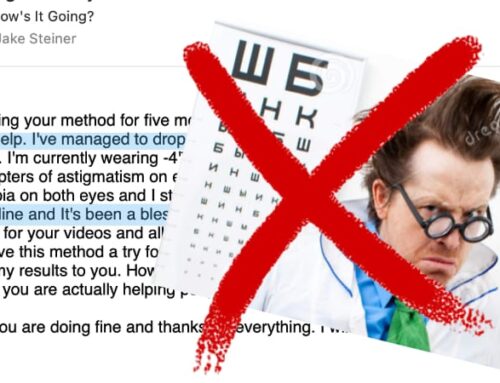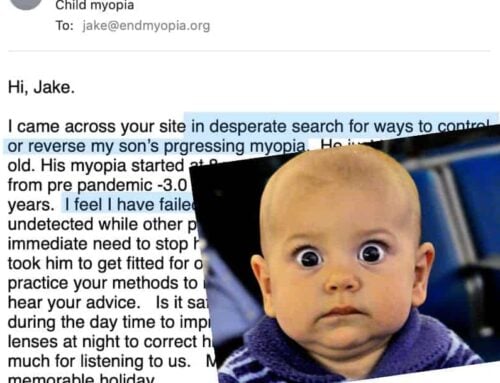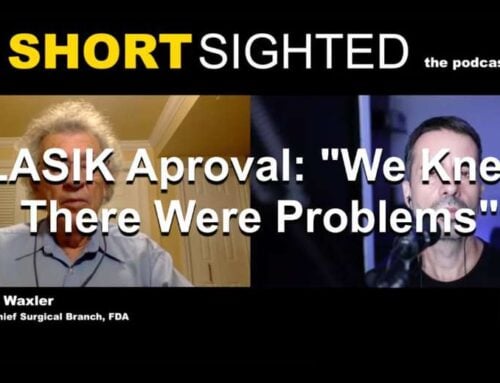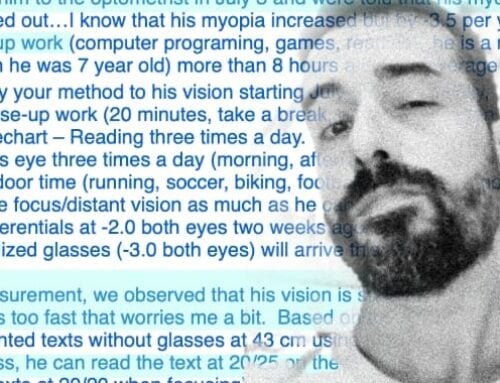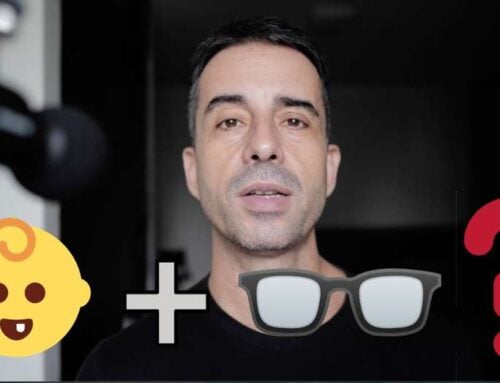More child myopia book excerpts:
“There are a variety of causes for the symptom commonly referred to as myopia. The symptom is also a bit more nuanced than the average optometrist visit will show you. Most optometrist visits, as we covered earlier, are just designed to sell you a prescription lens. There isn’t further discussion or exploration as to nuances of the symptom, or causes.
One question we need to get out of the way is whether myopia is genetic. The shortest possible answer to this is, yes. The slightly longer answer is, no.
Let’s explore this in a bit more detail. There is very likely a genetic component in myopia. Science which we have to lean on heavily here to fully understand your child’s eyesight, strongly leans towards genetics as a contributing factor to myopia, in at least some of its forms. Let’s look at some of the studies briefly, and then let’s figure out to what extent that might be relevant to your child.
In a 2003 Article in the Biochemistry and Molecular Biology section of IOVS, a link between autosomal dominant high myopia and chromosome 17 is being considered.
A quick excerpt from the study:
“A multigeneration English/Canadian family with AD severe myopia was ascertained. Myopes were healthy, with no clinical evidence of syndromic disease, anterior segment abnormalities, or glaucoma. The family contained 22 participating members (12 affected). The average age of diagnosis of myopia was 8.9 years (range, birth to 11 years). The average refractive error for affected adults was −13.925 D (range, −5.50 to −50.00).
The genome screening yielded a maximum two-point lod score of 3.17 at θ = 0.
Conclusions: A novel putative disease locus for AD high-grade myopia has been identified and provides additional support for genetic heterogeneity for this disorder.”
Jargon heavy things here. Bear with me, we will get to the point momentarily. Above basically suggests that genetics can have an effect on high myopia.
In November 1998, the American Society of Human genetics published this report:
“Myopia, or nearsightedness, is the most common eye disorder worldwide. “Pathologic” high myopia, or myopia of ≤−6.00 diopters, predisposes individuals to retinal detachment, macular degeneration, cataract, or glaucoma. A locus for autosomal dominant pathologic high myopia has been mapped to 18p11.31. We now report significant linkage of high myopia to a second locus at the 12q21-23 region in a large German/Italian family. The family had no clinical evidence of connective-tissue abnormalities or glaucoma. The average age at diagnosis of myopia was 5.9 years. The average spherical-component refractive error for the affected individuals was −9.47 diopters. Markers flanking or intragenic to the genes for the 18p locus, Stickler syndromes type I and II (12q13.1-q13.3 and 6p21.3), Marfan syndrome (15q21.1), and juvenile glaucoma (chromosome 1q21-q31) showed no linkage to the myopia in this family. The maximum LOD score with two-point linkage analysis in this pedigree was 3.85 at a recombination fraction of .0010, for markers D12S1706 and D12S327. Recombination events identified markers D12S1684 and D12S1605 as flanking markers that define a 30.1-cM interval on chromosome 12q21-23, for the second myopia gene. These results confirm genetic heterogeneity of myopia. The identification of this gene may provide insight into the pathophysiology of myopia and eye development.”
Here is what I want to show you. Notice how a single family affected by a high degree of myopia has the writers conclude an overarching “genetic heterogeneity of myopia”. While the method of the study is fine, the conclusion is a bit dramatic, considering limited scope of the analysis itself.
It’s these kinds of things that cause the mainstream to potentially falsely interpret the root cause of myopia. Remember, there is more than one kind of myopia (more on that shortly), and what we are looking at here is not the primary cause, rather contributing factors that may make someone more susceptible to become myopic.
There are many more of these types of studies, like one published in Nature Magazine in 2010, “a genome-wide association study for myopia and refractive error identifies a susceptibility locus at 15q25 “. Indeed the study finds a connection.
Or take a study published in 2005 in the Journal of Investigative Ophthalmology & Visual Science, titled “Identification of a Novel Locus on 2q for Autosomal Dominant High-Grade Myopia”. It too identifies a genetic connection to myopia.
Lots of studies, lots of different genetic markers, all competing to suggest that they found the cause. You want to have an idea about this, to get the full picture of why professionals argue about the cause of myopia. One problem here is the nature of the field, which is well summarized in the popular phrase, “publish or perish”. You have to conduct studies and publish them, if you want to remain relevant. This leads to a whole lot of noise and makes it harder to find out what actually matters.
Let’s get back to that, what actually matters to you, reading this book. You want to know how to keep your child’s eyes healthy. I’m trying to strike a balance here between telling you the whole story but also not making you fall asleep while reading. So let’s say that there is a lot of discussion about genetic causes. And let’s say that causes as such need to be considered in the order of importance (how much is genetics going to affect your child’s eyes?). We also want to look at things we can change, vs. the ones we can not.
So let’s look at one more study, just the highlights. This one is really important as it will put the whole “it’s genetic” argument in meaningful perspective for you. Take a look:
“In order to assess the relative and interactive importance of genetic and environmental components on the development of myopia in Chinese school children aged from 10 to 15 years, a population-based sample of 361 same-sexed twin pairs recruited through stratified cluster sampling was studied. Zygosity of twin pairs was determined by Mendelian traits, red cell antigen systems, and continuous dermatoglyphic characteristics; while myopia was diagnosed by both objective and subjective techniques. Studying and reading habit was obtained from cotwins and their parents through a life style questionnaire. Age-sex-adjusted concordance rate derived from multiple regression equation was used in the analysis.
Conventional comparison of intrapair concordance between monozygotic (MZ) and dizygotic (DZ) twins was used to assess the importance of a genetic component in the determining of myopia, and a significant genetic influence was observed. Environmental influence on myopia was evaluated through MZ cotwin method, and MZ cotwins with concordant studying and reading habits were significantly more concordant in myopia than those MZ cotwins with discordant habits. The possible effect of gene-environment interaction on myopia was explored, and concordance in myopia was found significantly associated with the interaction between zygosity and habit of studying and reading. These observations suggested that the impact of the environmental factor on the development of myopia may be influenced by genotype, and vice versa.”
This is what matters, when we talk about genetics. Yes, genetics affect your child’s likelihood of becoming myopic, and the degree of myopia. But genetics isn’t ultimately necessarily dictating whether your child will be myopic, only adding a factor of susceptibility. As this study using twins suggests, the environmental impact affecting myopia development can’t be ignored. While this doesn’t answer every question about myopia, it puts to bed one key argument: Genetics alone don’t doom your child to a life behind glasses. The environment matters. And you can affect the environment, thus affecting the vision health of your child.
All right, well done making it through this one! Genetics isn’t the most exciting topic, but we had to at least look at some of the debate there. Your child is going to be more likely, or less likely to be affected by the environment, depending on genes. This means that you may have to be more vigilant than other parents, if your child is exhibiting more notable symptoms. Next we’ll look at how you might assess this, and how specifically we might define “vigilant”, in terms of your child’s healthy eyeballs.”
—
I am posting these updates for two reasons:
One, a few of you are incredibly kind, leaving comments on our Facebook page. You don’t know how much that helps keeping my wee little brain on course and motivated.
You are darling angels! :)
And yes, we won’t actually make the title an obscure inside joke (even though I find it highly amusing).
Two, some of you are leaving incredibly valuable feedback. Truly, invaluable. One of you cautioned against using some specific terminology, and provided some suggestions on how to stay out of seriously hot waters with the establishment. It’s a fine line between providing some guidance here, and being shot out of the sky by the appointed rulers of eyesight health.
Not all optometrists are going to love me regardless after this one, but at least we’ll keep their less-than-love out of court rooms.
What I am posting are draft edits. Feedback, always helpful.
A lot of the rewrites will be focused on being a bit more huggey-inclusive of the mainstream. We can’t vilify them too much, if we want to have any hope of getting support from the people who dictate what reaches the public.
This won’t be easy for me. I have the unfortunate tendency of enjoying causing some annoyance among that crowd. :-)
But with your gentle prodding and a bit of time, it’ll come out all friendly to everyone!
UPDATE: Genetics, external stimulus, and more in this article (and video).
Cheers,
– Jake


